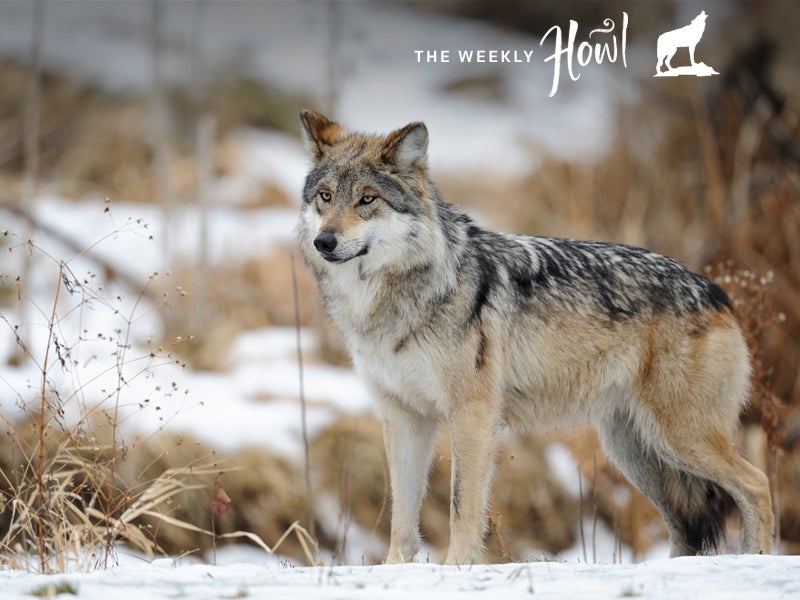Eight Wild Facts About the Rare and Elusive Lobo
The rare but iconic lobo, revealed.

This page was published 9 years ago. Find the latest on Earthjustice’s work.
Mexican gray wolves, a distinctive subspecies of gray wolves, were once top dogs of the American Southwest. At the turn of the century, the U.S. government began an eradication program that wiped out all but a handful of the wolves. The signature howl of the lobo that once rang out across the wild southwestern lands was all but silenced. In 1998, the U.S. Fish and Wildlife Service began a federal reintroduction program, but progress in the wolves’ recovery has been stymied by political interests. Today, fewer than 100 lobos remain in the wild.
Victimized by political forces and irrational fear, these lupines deserve a second chance—and a closer look. Here are eight wild facts about the iconic lobo:
- The Mexican gray wolf is among the most endangered mammals in North America and is the most endangered subspecies of wolf in the world. As of February 2016, there were only 97 Mexican gray wolves remaining in the wild. Their numbers have plummeted due to poaching, legal removals of wolves from the wild and high pup mortality. One of the biggest problems plaguing the wild population is a lack of genetic diversity.
- Lobos are about the size of German shepherds and Labrador retrievers, and they weigh between 50 and 85 pounds each. They are the smallest subspecies of gray wolf in North America—about half the size of North American gray wolves.
- Mexican gray wolves are very social animals. They communicate through howling, body language and scent marking. A lobo pack is like an extended family, led by an alpha pair. Each spring, the alpha female gives birth to a litter of pups and the whole pack helps raise and feed them. Adults are very tolerant of growing pups and feed the young wolves by chewing and regurgitating their kills.
- Like the wolves of Yellowstone, Mexican gray wolves are lynchpins of their ecosystems. If lobo numbers return to normal, biologists believe the wolves will restore balance to Southwest ecosystems by preying on deer, elk and javelin (similar to wild pigs). Wolves weed out the old, young and sick, preventing prey populations from growing so large that they overgraze and destroy habitat that countless other species depend on.
- Right now, Mexican gray wolves have limited protection under the Endangered Species Act because they are labeled an “experimental population.” This means that the U.S. Fish and Wildlife Service can manage the wolves under more lenient rules that permit wolf “takes”—killing or harassing wolves or damaging habitat necessary for the survival and recovery of the species.
- Every Mexican gray wolf in the wild today is a descendent of just seven wolves that were founding members of a nationwide captive breeding program. That means the lobos’ genetic diversity is dangerously low, resulting in low adaptability and smaller litters of pups. The only solution is to supplement their gene pool by releasing more lobos from captivity into the wild. If action is not taken to protect and expand wild lobo populations, these iconic creatures are doomed to extinction.
- Lobos tend to roam, largely due to their natural need to carve out distinctive territories separate from those of other wolf packs. They once ranged from central Mexico through the southwestern U.S., but now they’re found almost exclusively in the Apache National Forest and the Gila National Forest on the Arizona-New Mexico border. Current management rules for the lobo do not provide enough room for a healthy population to take hold. Earthjustice is advocating for the expansion of the wolves’ geographic range to include the Grand Canyon, a site favored by wolf biologists for the species’ recovery.
- Due to political constraints, as of now only newborn lobo pups are being released from captivity into the wild. In a complex process known as cross-fostering, the U.S. Fish and Wildlife Service takes captive-born pups from zoos and wolf sanctuaries into the wild to be placed with wild litters. The process is complicated and invasive, but it is currently the only means of increasing genetic diversity in the wild population.
The U.S. Fish and Wildlife Service is finally working on a recovery plan to help bring Mexican gray wolves back from the brink. Make your voice heard by telling the agency to design a strong and scientifically sound plan to boost wild wolf populations by releasing more wolves from captivity and by expanding their range so that the iconic howl of the lobo can ring out across the Grand Canyon.
About this series
2015 marked the 20th anniversary of the reintroduction of gray wolves to the northern Rockies, and since that time wolves have been under nearly constant threat of losing their protections. The Weekly Howl provides insights and education about the gray wolf and updates on the status of its protections while celebrating the iconic species as a vital part of a functioning, healthy ecosystem. Posts ran through the summer of 2015 and resumed in the fall of 2016.